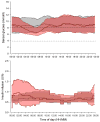Home use of closed-loop insulin delivery for overnight glucose control in adults with type 1 diabetes: a 4-week, multicentre, randomised crossover study
- PMID: 24943065
- PMCID: PMC4165604
- DOI: 10.1016/S2213-8587(14)70114-7
Home use of closed-loop insulin delivery for overnight glucose control in adults with type 1 diabetes: a 4-week, multicentre, randomised crossover study
Abstract
Background: Closed-loop insulin delivery is a promising option to improve glycaemic control and reduce the risk of hypoglycaemia. We aimed to assess whether overnight home use of automated closed-loop insulin delivery would improve glucose control.
Methods: We did this open-label, multicentre, randomised controlled, crossover study between Dec 1, 2012, and Dec 23, 2014, recruiting patients from three centres in the UK. Patients aged 18 years or older with type 1 diabetes were randomly assigned to receive 4 weeks of overnight closed-loop insulin delivery (using a model-predictive control algorithm to direct insulin delivery), then 4 weeks of insulin pump therapy (in which participants used real-time display of continuous glucose monitoring independent of their pumps as control), or vice versa. Allocation to initial treatment group was by computer-generated permuted block randomisation. Each treatment period was separated by a 3-4 week washout period. The primary outcome was time spent in the target glucose range of 3·9-8·0 mmol/L between 0000 h and 0700 h. Analyses were by intention to treat. This trial is registered with ClinicalTrials.gov, number NCT01440140.
Findings: We randomly assigned 25 participants to initial treatment in either the closed-loop group or the control group, patients were later crossed over into the other group; one patient from the closed-loop group withdrew consent after randomisation, and data for 24 patients were analysed. Closed loop was used over a median of 8·3 h (IQR 6·0-9·6) on 555 (86%) of 644 nights. The proportion of time when overnight glucose was in target range was significantly higher during the closed-loop period compared to during the control period (mean difference between groups 13·5%, 95% CI 7·3-19·7; p=0·0002). We noted no severe hypoglycaemic episodes during the control period compared with two episodes during the closed-loop period; these episodes were not related to closed-loop algorithm instructions.
Interpretation: Unsupervised overnight closed-loop insulin delivery at home is feasible and could improve glucose control in adults with type 1 diabetes.
Funding: Diabetes UK.
Copyright © 2014 Elsevier Ltd. All rights reserved.
Conflict of interest statement
Figures




Comment in
-
The artificial pancreas: a digital-age treatment for diabetes.Lancet Diabetes Endocrinol. 2014 Sep;2(9):679-81. doi: 10.1016/S2213-8587(14)70126-3. Epub 2014 Jun 16. Lancet Diabetes Endocrinol. 2014. PMID: 24943066 Free PMC article. No abstract available.
Similar articles
-
Closed-loop insulin delivery in suboptimally controlled type 1 diabetes: a multicentre, 12-week randomised trial.Lancet. 2018 Oct 13;392(10155):1321-1329. doi: 10.1016/S0140-6736(18)31947-0. Epub 2018 Oct 3. Lancet. 2018. PMID: 30292578 Free PMC article. Clinical Trial.
-
Day-and-night glycaemic control with closed-loop insulin delivery versus conventional insulin pump therapy in free-living adults with well controlled type 1 diabetes: an open-label, randomised, crossover study.Lancet Diabetes Endocrinol. 2017 Apr;5(4):261-270. doi: 10.1016/S2213-8587(17)30001-3. Epub 2017 Jan 14. Lancet Diabetes Endocrinol. 2017. PMID: 28094136 Free PMC article. Clinical Trial.
-
Closed-loop insulin delivery in adults with type 1 diabetes in real-life conditions: a 12-week multicentre, open-label randomised controlled crossover trial.Lancet Digit Health. 2019 May;1(1):e17-e25. doi: 10.1016/S2589-7500(19)30003-2. Epub 2019 May 2. Lancet Digit Health. 2019. PMID: 33323237 Clinical Trial.
-
Artificial pancreas: fuzzy logic and control of glycemia.Curr Opin Endocrinol Diabetes Obes. 2014 Aug;21(4):251-6. doi: 10.1097/MED.0000000000000073. Curr Opin Endocrinol Diabetes Obes. 2014. PMID: 24937038 Review.
-
Glucose-responsive insulin delivery for type 1 diabetes: The artificial pancreas story.Int J Pharm. 2018 Jun 15;544(2):309-318. doi: 10.1016/j.ijpharm.2017.12.022. Epub 2017 Dec 16. Int J Pharm. 2018. PMID: 29258910 Review.
Cited by
-
Model-Free Machine Learning in Biomedicine: Feasibility Study in Type 1 Diabetes.PLoS One. 2016 Jul 21;11(7):e0158722. doi: 10.1371/journal.pone.0158722. eCollection 2016. PLoS One. 2016. PMID: 27441367 Free PMC article.
-
Efficacy and safety of the artificial pancreas in the paediatric population with type 1 diabetes.J Transl Med. 2018 Jun 28;16(1):176. doi: 10.1186/s12967-018-1558-8. J Transl Med. 2018. PMID: 29954380 Free PMC article. Review.
-
Twelve-Week 24/7 Ambulatory Artificial Pancreas With Weekly Adaptation of Insulin Delivery Settings: Effect on Hemoglobin A1c and Hypoglycemia.Diabetes Care. 2017 Dec;40(12):1719-1726. doi: 10.2337/dc17-1188. Epub 2017 Oct 13. Diabetes Care. 2017. PMID: 29030383 Free PMC article. Clinical Trial.
-
Effectiveness of continuous glucose monitoring systems on glycemic control in adults with type 1 diabetes: A systematic review and meta-analysis.Metabol Open. 2025 Jul 29;27:100382. doi: 10.1016/j.metop.2025.100382. eCollection 2025 Sep. Metabol Open. 2025. PMID: 40791933 Free PMC article.
-
Influences on Technology Use and Efficacy in Type 1 Diabetes.J Diabetes Sci Technol. 2016 May 3;10(3):647-55. doi: 10.1177/1932296816639315. Print 2016 May. J Diabetes Sci Technol. 2016. PMID: 27022096 Free PMC article. Review.
References
-
- The effect of intensive treatment of diabetes on the development and progression of long-term complications in insulin-dependent diabetes mellitus. The Diabetes Control and Complications Trial Research Group. N Engl J Med. 1993;329(14):977–86. - PubMed
-
- Epidemiology of severe hypoglycemia in the diabetes control and complications trial. The DCCT Research Group. Am J Med. 1991;90(4):450–9. - PubMed
-
- McCoy RG, Van Houten HK, Ziegenfuss JY, Shah ND, Wermers RA, Smith SA. Self-report of hypoglycemia and health-related quality of life in patients with type 1 and type 2 diabetes. Endocr Pract. 2013;19(5):792–9. - PubMed
-
- Monami M, Marchionni N, Mannucci E. Long-acting insulin analogues vs. NPH human insulin in type 1 diabetes. A meta-analysis. Diabetes Obes Metab. 2009;11(4):372–8. - PubMed
-
- Rankin D, Cooke DD, Clark M, et al. How and why do patients with Type 1 diabetes sustain their use of flexible intensive insulin therapy? A qualitative longitudinal investigation of patients’ self-management practices following attendance at a Dose Adjustment for Normal Eating (DAFNE) course. Diabet Med. 2011;28(5):532–8. - PubMed
Publication types
MeSH terms
Substances
Associated data
Grants and funding
LinkOut - more resources
Full Text Sources
Other Literature Sources
Medical
Research Materials

